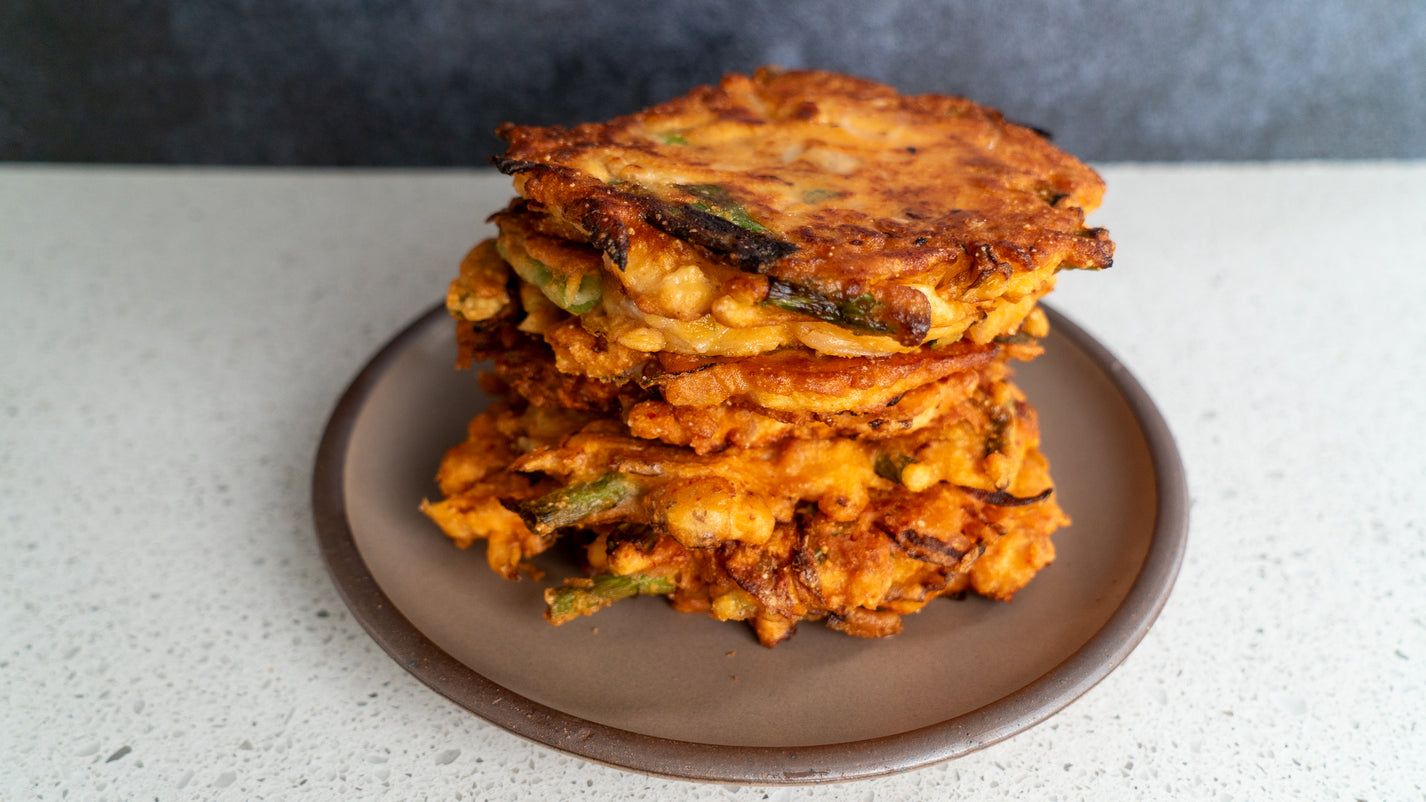Here's something approaching my late mom's recipe for bindaetteok. This Korean dish, a sort of mung bean pancake, has a special place in my heart. My mom would make hundreds of them during the holidays. She'd have the counter filled with electric griddles and 5-gallon buckets of bindaetteok batter on the floor. She'd kept stacks of cooked binedaetteok in the freezer for months and reheat them as needed. For special occasions like holidays and birthdays, she'd make them fresh. Most people have some kind of dish that connects them to their parents to some degree, and this one is mine. My mother was born and raised in Kaesong, a mountainous town in North Korea, and this was the dish that her mom made and her mom before that made, so this is a recipe that's been running for a long time in the Chang family. The thing is, she never wrote down the recipe. And she probably changed it over the years. So this isn't exactly Mama Chang's bindaetteok, but it's close. Just making it gives me so much nostalgia. And I take great pleasure in the idea that I may never remake my mom's recipe exactly but will always be in pursuit of its elusiveness taste. Ultimately it's a pretty simple dish: You puree soaked mung beans with rice to make a batter, add some onions and scallions to it—maybe some kimchi and pork, too—and then fry it in rounds like pancakes. You really can't eat it without the sauce: the vinegar in the sauce balances out the heaviness of the beans, fat, and starch in the bindaetteok. And the soy sauce provides the seasoning. - Dave Chang
Makes about 15 bindaetteok, each about 5-inch diameter
Bindaetteok
- 3 cups peeled (split) yellow mung beans
- 3/4 cup short-grain sweet glutinous rice
- 1/2 large onion
- 8 to 10 scallions
- 12 ounces pork belly
- 1 1/2 to 2 cups kimchi
- 1 to 1 1/2 teaspoons kosher salt
- About 1 teaspoon monosodium glutamate, such as Ac'cent® brand, optional
- 1/2 to 1 teaspoon sugar, optional
- Oil, for frying
Dipping Sauce
- 1 garlic clove
- 3 tablespoons tamari or soy sauce
- 2 tablespoons rice vinegar
- 1 tablespoon agave nectar or 1 teaspoon sugar
- 2 teaspoons toasted sesame oil
- 2 tablespoons toasted sesame seeds
- 1 to 2 teaspoons gochugaru (Korean chili flakes), optional
- For the bindaetteok, put the yellow mung beans in a medium bowl, cover with cold water, and let soak overnight (8 hours) at room temperature. Do the same with the rice, but in a smaller bowl.
- Drain the mung beans in a fine-mesh sieve and rinse with cold water until the water runs clear. Combine the soaked beans with about 1 1/2 cups water in a blender. Pulse to a coarse puree. You don't want a silky-smooth puree; you want it somewhat coarse so you can feel the texture of the mung beans. Scrape the ground bean mixture into a large mixing bowl.
- Dump the rice-water mix into the same blender. For this blending, you do want a smooth puree, so let it go a little longer. The starch in the rice is your binder (kind of like wheat flour in American pancake batter) so you want to puree the soaked rice pretty smooth. Scrape about half the rice puree into the mung beans and mix them together. Add more rice puree as necessary to create medium-thin pancake-type batter. Getting this ratio right is one of the keys to great bindaetteok.
- Thinly slice the onion and add to the batter. Cut the scallion greens into 1 to 1 1/2-inch lengths and add those to the batter. Save the scallion whites for the dipping sauce.
- If your pork belly isn't sliced in long strips like bacon, slice it up so it looks like bacon strips. Then stack the strips and cut crosswise into pieces about the same size as the scallions (about 1/4-inch wide and 1 to 1 1/2 inches long). Add the raw pork to the batter.
- Dump your kimchi onto the cutting board and line up the cabbage pieces so you can slice them into strips about the same width and length as the scallions and pork. Add the sliced kimchi to the batter along with the salt, MSG (if using), and sugar (if using). Mix everything together real good. The batter should be somewhat like a thin glue that almost holds the solid veg together (again that rice-water-bean ratio is key).
- Put several skillets over medium-low heat and add a healthy amount of frying oil to each one—enough to thickly cover the pan bottoms. You can also use a giant griddle if it has a lip to hold the oil.
- When the oil is shimmering, scoop up a little less than 1 cup of batter for each bindaetteok. Place the batter in the pan(s), flattening each bindaetteok to a thickness of about 1/4-inch or thinner and about 5 inches in diameter. Fry slowly until the pork is cooked through and the bindaetteok are deep golden brown on both sides, 5 to 7 minutes per side. They should get nice and crisp on the edges. As they're done, remove them to paper towels to drain.
- For the dipping sauce: Thinly slice the whites from about 6 of the scallions used for the bindaetteok and place in a medium-small bowl. Mince and mash the garlic to a paste with your knife and add to the bowl. Stir in the tamari or soy sauce, vinegar, agave or sugar, sesame oil, sesame seeds, and gochugaru (if using).
- Serve stacks of warm bindaetteok with the sauce for dipping.
Watch the full recipe video on the Majordomo YouTube Channel

